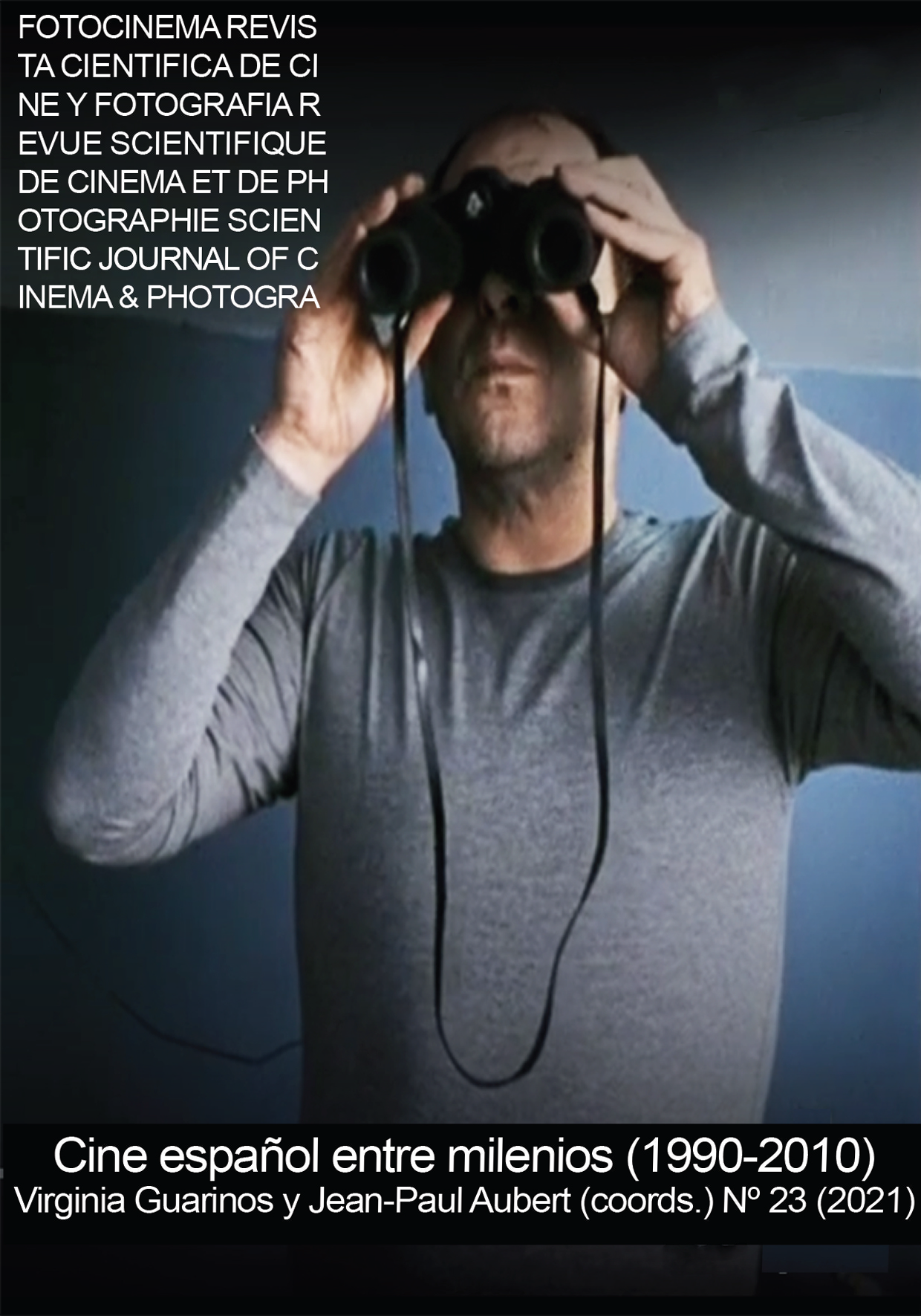La gestión del secreto en la filmografía de Alan J. Pakula.
DOI:
https://doi.org/10.24310/Fotocinema.2021.v23i.12385Keywords:
Alan J. Pakula, director, producer, suspense, secrecyAbstract
New Yorker Alan J. Pakula is a film director who made the management of secrecy the central element of his filmography- His initial experience as a producer has led him to develop his own style in which the comercial is not at odds with the quality of the story, looking for added attraction for the viewer in suspense and action. It hsa in all its films with big stars that ensure the success of the box office. This article focuses, however, on the analysis of the dark areas, the shadows of the “official versions”, the power plots, the monsters of the subconscious, the unspeakable violence and other narrative warps of his cinema, which make the management of secrecy in the narrative concrete that sustains the intriguing world of his filmography.
Downloads
Metrics
Publication Facts
Reviewer profiles N/A
Author statements
Indexed in
-
—
- Academic society
- N/A
- Publisher
- Universidad de Málaga
References
Bernstein, C. & Woodward, R. (2017). Todos los hombres del presidente. Barcelona: Los libros del Lince.
Brown, J. (2005). Alan J. Pakula. His films and his life. New York: Back Stage Books.
Castillo, M. (14 de agosto de 2020). What the Paranoid `70s Thrillers of Alan J. Pakula can teach us about 2020. Inside Hook. Recuperado de: https://www.insidehook.com/article/movies/alan-j-pakula-1970s-thriller-teacsus-about-present
Del Valle, D. (2004). Klute (1971). En S. J. Schneider (Ed.), 1001 películas que hay que ver antes de morir (p.541). Barcelona: Grijalbo.
Ebert, R. (27 de julio de 1990). Presummed Innocent. Rogerebert.com. https://www.rogerebert.com/
Galindo, F. (2003). Ámbitos del Periodismo de Precisión. Santiago de Compostela: Tórculo.
González, J. C. (6 de marzo de 2016). Inocencia preservada: Matar a un ruiseñor, de Robert Mulligan. Revista Generación, suplemento del periódico El Colombiano. Recuperado de: https://www.tiempodecine.co/web/matar-a-un-ruisenor-del-libro-al-cine/
Grisham, J. (1992). El Informe Pelícano. Barcelona: Planeta.
Jabois, M. (19 de noviembre de 2019) ¿Es Hollywood un ventilador de ideas izquierdistas? El País. Recuperado de https://elpais.com/elpais/2019/11/08/ideas/1573239884_109102.html
Kazan, Elia (2005). En qué consiste ser director. En J. Kagan (Ed.), La mirada del director. Entrevistas con directores de cine (pp. 323-338). Madrid: Plot Ediciones.
Kemp, P. (2011). Cine. Toda la historia. Barcelona: Blume.
Laborde, A. (10 de noviembre de 2019). Actriz de puño en alto. El País. Recuperado de https://elpais.com/elpais/2019/11/08/ideas/1573211042_322121.html
Larrea, C. (2011). En busca de la verdad. Riobamba: UNACH.
Laurier, J. & Walsh, D. (11 de abril de 2019). En defensa de To Kill a Mockingbird (Matar a un ruiseñor): película de 1962 que vuelve a los cines esta semana. World Socialist Web. Recuperado de https://www.wsws.org/es/articles/2019/04/11/mock-a11.html
Lazic, E. (7 de abril de 2020). In praise of Comes a Horseman, Alan J. Pakula´s neglected western. British Film Institute/Features. Recuperado de https://www.bfi.org.uk/features/praise-comes-horseman-alan-j-pakulas-neglected-western
Lee, H. (2021). Matar a un ruiseñor. New York: Harpercollins.
Lee, H. (2017). Ve y pon un centinela. New York: Harpercollins.
Meyer, P. (1993). Periodismo de Precisión. Barcelona: Bosch.
Morin, E. (2001). El cine o el hombre imaginario. Barcelona: Seix Barral.
Pardo, P. (12 de julio de 2015): El ruiseñor vuelve a volar. El Mundo. Recuperado de https://www.elmundo.es/cultura/2015/07/12/55a148d5e2704e93688b4588.html
Pakula, A. J. (1950-1998). Alan Pakula Papers (Special Collections). Margaret Herrick Library (Online Archive of California, OAC). California: Online Archive of California. Recuperado de https://oac.cdlib.org/findaid/ark:/13030/c8v69kxw/entire_text/
Romero, R. (2012). La pantalla de la justicia. Matar a un ruiseñor cincuenta años después. L´Atalante. Revista de Estudios Cinematográficos (14), pp. 99-107. Recuperado de file:///C:/Users/Usuario/Downloads/La_pantalla_de_la_justicia_Matar_a_un_ru.pdf
Sánchez, J. L. (2002). Historia del Cine. Teoría y géneros cinematográficos, fotografía y televisión. Madrid: Alianza Editorial.
Sayej, N. (5 de noviembre de 2019). Finally, a documentary on filmmaker Alan J. Pakula. Forbes. Recuperado de https://www.forbes.com/sites/nadjasayej/2019/11/05/finally-a-new-documentary-on-filmmaker-alan-j-pakula/?sh=35c1a53922e6
Schickel, R. (20 de diciembre de 1963). Just a little film to frighten you silly. Life. Recuperado de https://books.google.es/books?id=QVQEAAAAMBAJ&pg=PA10&dq=robert+mulligan+movies&hl=es&sa=X&ved=2ahUKEwjht_zm4P_uAhULlxQKHbPsDEQQ6AEwBXoECAUQAg#v=onepage&q=robert%20mulligan%20movies&f=false
Schwartz, H. (28 de febrero de 2018). A brilliant, often controversial cinematographer shares his considerable expertise with student filmmakers of the American Film Institute. American Cinematographer. Recuperado de https://ascmag.com/articles/flashback-gordon-willis-asc-interview-at-afi-part-i
Styron, W. (2000). La decisión de Sophie. Barcelona: Random House.
Tavernier, B. & Coursodon, J-P. (1997). 50 años de cine norteamericano. Barcelona: Akal.
Turrow, S. (2006). Presunto inocente. Barcelona: Debolsillo.
Downloads
Published
How to Cite
Issue
Section
License
All contents published in Fotocinema Revista científica de cine y fotografía are protected under the Creative Commons Attribution-NonCommercial-ShareAlike 4.0 International (CC BY-NC-SA 4.0) license. All about this license is available in the following link: <http://creativecommons.org/licenses/by-nc-sa/4.0>
Users can copy, use, redistribute, share and exhibit publicly as long as:
- The original source and authorship of the material are cited (Journal, Publisher and URL of the work).
- It is not used for comercial purposes.
- The existence of the license and its especifications are mentioned.
There are two sets of authors’ rights: moral and property rights. Moral rights are perpetual prerogatives, unrenounceable, not-transferable, unalienable, imprescriptible and inembargable. According to authors’ rights legislation, Fotocinema. Revista científica de cine y fotografía recognizes and respects authors moral rights, as well as the ownership of property rights, which will be transferred to University of Malaga in open access. The property rights are referred to the benefits that are gained by the use or the dissemination of works. Fotocinema. Revista científica de cine y fotografía is published in an open access form and it is exclusively licenced by any means for doing or authorising distribution, dissemination, reproduction, , adaptation, translation or arrangement of works.
Authors are responsable for obtaining the necessary permission to use copyrighted images.














13.png)



